Hyde Park Barracks: History, Significance, and Preservation Efforts
VerifiedAdded on 2023/04/23
|7
|2637
|358
Report
AI Summary
This report provides a comprehensive overview of the Hyde Park Barracks in Sydney, Australia, a site of immense historical and cultural significance. Initially constructed under the rule of Administrator Lachlan Macquarie from 1817 to 1819, the barracks served as accommodation for male government-assigned convicts. The essay details the barracks' evolution from a convict establishment to a female refuge, and ultimately, a museum managed by the Historic Houses Trust of New South Wales. The design by convict architect Francis Greenway and the archaeological findings add layers of understanding to the site's history. The report emphasizes the barracks' importance in illustrating the convict experience, the history of the region, and its designation as a World Heritage Site. The document also explores the social and historical contexts, including the challenges faced by convicts and the significance of the site in the 19th century. Today, the museum offers insights into the lives of the prisoners and other inhabitants through various exhibits, making it an essential place for understanding the past of New South Wales.
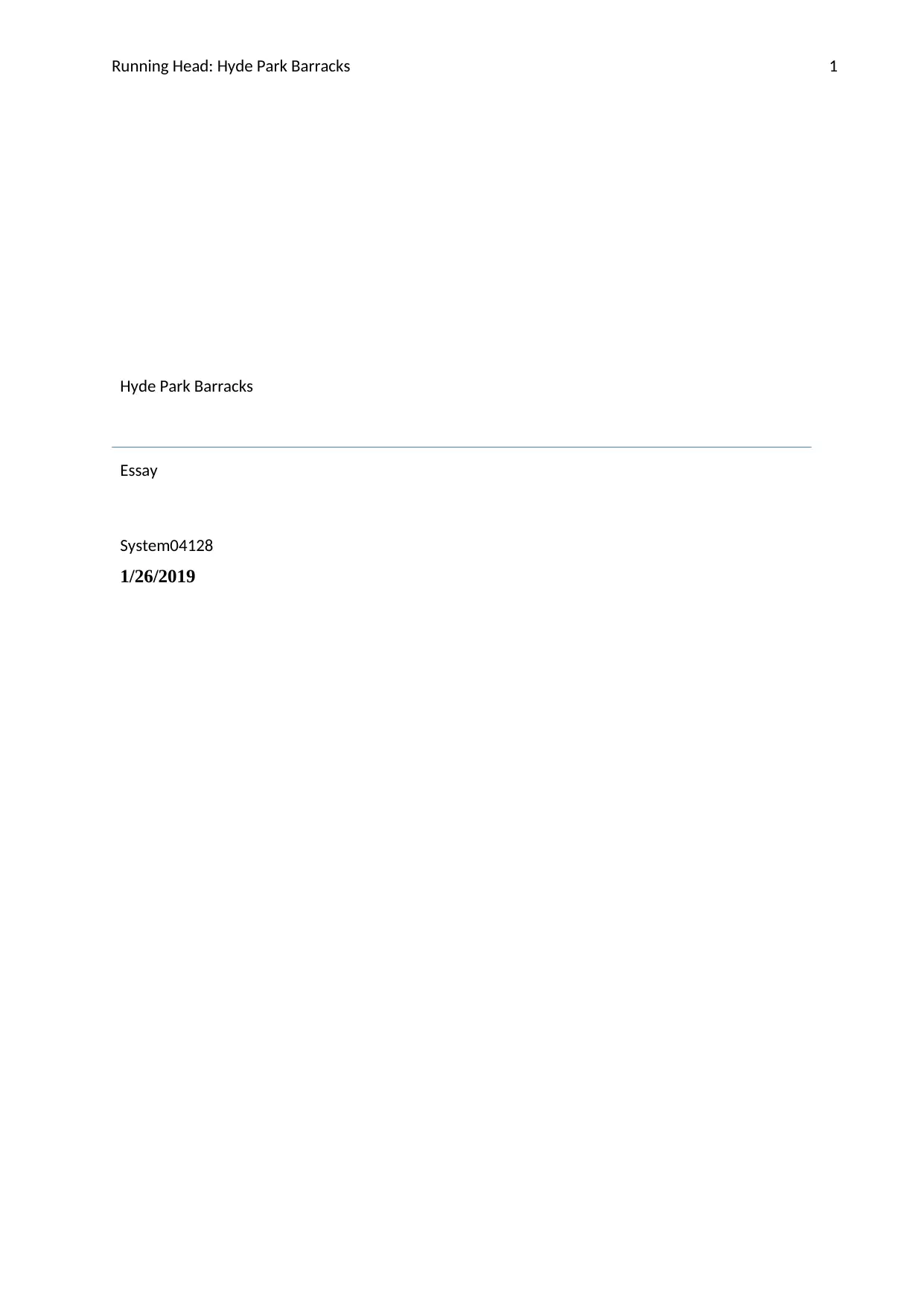
Running Head: Hyde Park Barracks 1
Hyde Park Barracks
Essay
System04128
1/26/2019
Hyde Park Barracks
Essay
System04128
1/26/2019
Paraphrase This Document
Need a fresh take? Get an instant paraphrase of this document with our AI Paraphraser
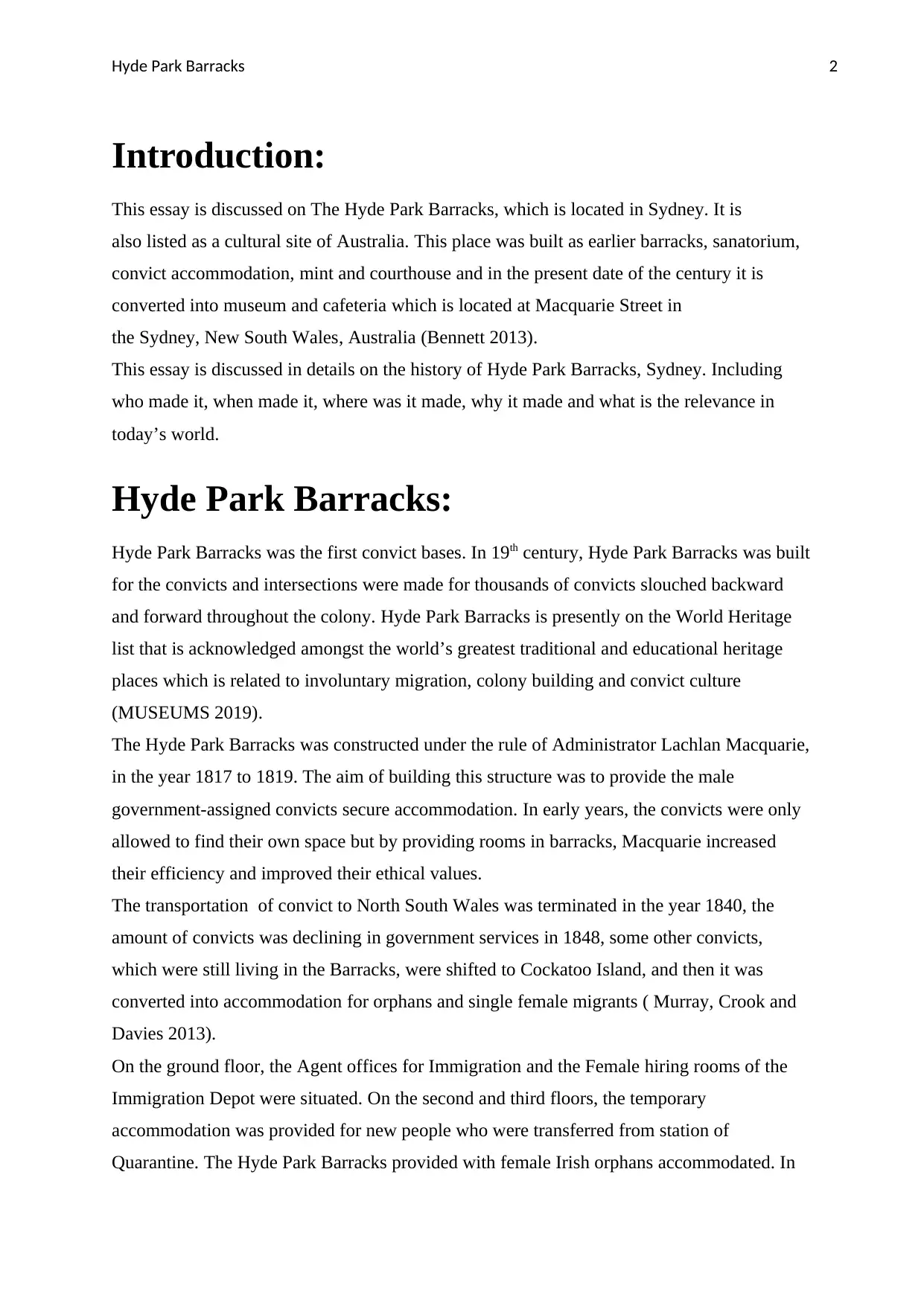
Hyde Park Barracks 2
Introduction:
This essay is discussed on The Hyde Park Barracks, which is located in Sydney. It is
also listed as a cultural site of Australia. This place was built as earlier barracks, sanatorium,
convict accommodation, mint and courthouse and in the present date of the century it is
converted into museum and cafeteria which is located at Macquarie Street in
the Sydney, New South Wales, Australia (Bennett 2013).
This essay is discussed in details on the history of Hyde Park Barracks, Sydney. Including
who made it, when made it, where was it made, why it made and what is the relevance in
today’s world.
Hyde Park Barracks:
Hyde Park Barracks was the first convict bases. In 19th century, Hyde Park Barracks was built
for the convicts and intersections were made for thousands of convicts slouched backward
and forward throughout the colony. Hyde Park Barracks is presently on the World Heritage
list that is acknowledged amongst the world’s greatest traditional and educational heritage
places which is related to involuntary migration, colony building and convict culture
(MUSEUMS 2019).
The Hyde Park Barracks was constructed under the rule of Administrator Lachlan Macquarie,
in the year 1817 to 1819. The aim of building this structure was to provide the male
government-assigned convicts secure accommodation. In early years, the convicts were only
allowed to find their own space but by providing rooms in barracks, Macquarie increased
their efficiency and improved their ethical values.
The transportation of convict to North South Wales was terminated in the year 1840, the
amount of convicts was declining in government services in 1848, some other convicts,
which were still living in the Barracks, were shifted to Cockatoo Island, and then it was
converted into accommodation for orphans and single female migrants ( Murray, Crook and
Davies 2013).
On the ground floor, the Agent offices for Immigration and the Female hiring rooms of the
Immigration Depot were situated. On the second and third floors, the temporary
accommodation was provided for new people who were transferred from station of
Quarantine. The Hyde Park Barracks provided with female Irish orphans accommodated. In
Introduction:
This essay is discussed on The Hyde Park Barracks, which is located in Sydney. It is
also listed as a cultural site of Australia. This place was built as earlier barracks, sanatorium,
convict accommodation, mint and courthouse and in the present date of the century it is
converted into museum and cafeteria which is located at Macquarie Street in
the Sydney, New South Wales, Australia (Bennett 2013).
This essay is discussed in details on the history of Hyde Park Barracks, Sydney. Including
who made it, when made it, where was it made, why it made and what is the relevance in
today’s world.
Hyde Park Barracks:
Hyde Park Barracks was the first convict bases. In 19th century, Hyde Park Barracks was built
for the convicts and intersections were made for thousands of convicts slouched backward
and forward throughout the colony. Hyde Park Barracks is presently on the World Heritage
list that is acknowledged amongst the world’s greatest traditional and educational heritage
places which is related to involuntary migration, colony building and convict culture
(MUSEUMS 2019).
The Hyde Park Barracks was constructed under the rule of Administrator Lachlan Macquarie,
in the year 1817 to 1819. The aim of building this structure was to provide the male
government-assigned convicts secure accommodation. In early years, the convicts were only
allowed to find their own space but by providing rooms in barracks, Macquarie increased
their efficiency and improved their ethical values.
The transportation of convict to North South Wales was terminated in the year 1840, the
amount of convicts was declining in government services in 1848, some other convicts,
which were still living in the Barracks, were shifted to Cockatoo Island, and then it was
converted into accommodation for orphans and single female migrants ( Murray, Crook and
Davies 2013).
On the ground floor, the Agent offices for Immigration and the Female hiring rooms of the
Immigration Depot were situated. On the second and third floors, the temporary
accommodation was provided for new people who were transferred from station of
Quarantine. The Hyde Park Barracks provided with female Irish orphans accommodated. In
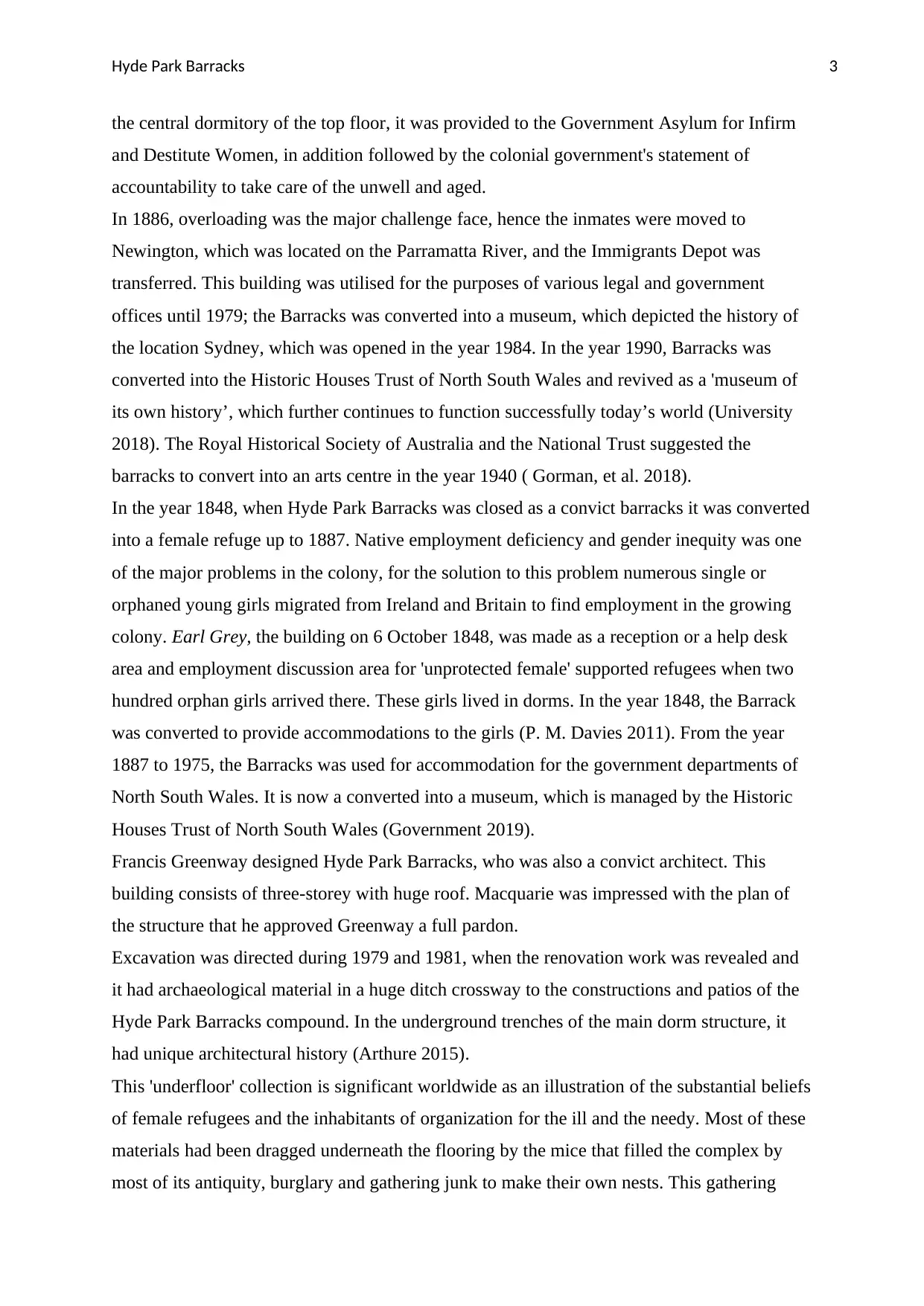
Hyde Park Barracks 3
the central dormitory of the top floor, it was provided to the Government Asylum for Infirm
and Destitute Women, in addition followed by the colonial government's statement of
accountability to take care of the unwell and aged.
In 1886, overloading was the major challenge face, hence the inmates were moved to
Newington, which was located on the Parramatta River, and the Immigrants Depot was
transferred. This building was utilised for the purposes of various legal and government
offices until 1979; the Barracks was converted into a museum, which depicted the history of
the location Sydney, which was opened in the year 1984. In the year 1990, Barracks was
converted into the Historic Houses Trust of North South Wales and revived as a 'museum of
its own history’, which further continues to function successfully today’s world (University
2018). The Royal Historical Society of Australia and the National Trust suggested the
barracks to convert into an arts centre in the year 1940 ( Gorman, et al. 2018).
In the year 1848, when Hyde Park Barracks was closed as a convict barracks it was converted
into a female refuge up to 1887. Native employment deficiency and gender inequity was one
of the major problems in the colony, for the solution to this problem numerous single or
orphaned young girls migrated from Ireland and Britain to find employment in the growing
colony. Earl Grey, the building on 6 October 1848, was made as a reception or a help desk
area and employment discussion area for 'unprotected female' supported refugees when two
hundred orphan girls arrived there. These girls lived in dorms. In the year 1848, the Barrack
was converted to provide accommodations to the girls (P. M. Davies 2011). From the year
1887 to 1975, the Barracks was used for accommodation for the government departments of
North South Wales. It is now a converted into a museum, which is managed by the Historic
Houses Trust of North South Wales (Government 2019).
Francis Greenway designed Hyde Park Barracks, who was also a convict architect. This
building consists of three-storey with huge roof. Macquarie was impressed with the plan of
the structure that he approved Greenway a full pardon.
Excavation was directed during 1979 and 1981, when the renovation work was revealed and
it had archaeological material in a huge ditch crossway to the constructions and patios of the
Hyde Park Barracks compound. In the underground trenches of the main dorm structure, it
had unique architectural history (Arthure 2015).
This 'underfloor' collection is significant worldwide as an illustration of the substantial beliefs
of female refugees and the inhabitants of organization for the ill and the needy. Most of these
materials had been dragged underneath the flooring by the mice that filled the complex by
most of its antiquity, burglary and gathering junk to make their own nests. This gathering
the central dormitory of the top floor, it was provided to the Government Asylum for Infirm
and Destitute Women, in addition followed by the colonial government's statement of
accountability to take care of the unwell and aged.
In 1886, overloading was the major challenge face, hence the inmates were moved to
Newington, which was located on the Parramatta River, and the Immigrants Depot was
transferred. This building was utilised for the purposes of various legal and government
offices until 1979; the Barracks was converted into a museum, which depicted the history of
the location Sydney, which was opened in the year 1984. In the year 1990, Barracks was
converted into the Historic Houses Trust of North South Wales and revived as a 'museum of
its own history’, which further continues to function successfully today’s world (University
2018). The Royal Historical Society of Australia and the National Trust suggested the
barracks to convert into an arts centre in the year 1940 ( Gorman, et al. 2018).
In the year 1848, when Hyde Park Barracks was closed as a convict barracks it was converted
into a female refuge up to 1887. Native employment deficiency and gender inequity was one
of the major problems in the colony, for the solution to this problem numerous single or
orphaned young girls migrated from Ireland and Britain to find employment in the growing
colony. Earl Grey, the building on 6 October 1848, was made as a reception or a help desk
area and employment discussion area for 'unprotected female' supported refugees when two
hundred orphan girls arrived there. These girls lived in dorms. In the year 1848, the Barrack
was converted to provide accommodations to the girls (P. M. Davies 2011). From the year
1887 to 1975, the Barracks was used for accommodation for the government departments of
North South Wales. It is now a converted into a museum, which is managed by the Historic
Houses Trust of North South Wales (Government 2019).
Francis Greenway designed Hyde Park Barracks, who was also a convict architect. This
building consists of three-storey with huge roof. Macquarie was impressed with the plan of
the structure that he approved Greenway a full pardon.
Excavation was directed during 1979 and 1981, when the renovation work was revealed and
it had archaeological material in a huge ditch crossway to the constructions and patios of the
Hyde Park Barracks compound. In the underground trenches of the main dorm structure, it
had unique architectural history (Arthure 2015).
This 'underfloor' collection is significant worldwide as an illustration of the substantial beliefs
of female refugees and the inhabitants of organization for the ill and the needy. Most of these
materials had been dragged underneath the flooring by the mice that filled the complex by
most of its antiquity, burglary and gathering junk to make their own nests. This gathering
⊘ This is a preview!⊘
Do you want full access?
Subscribe today to unlock all pages.

Trusted by 1+ million students worldwide
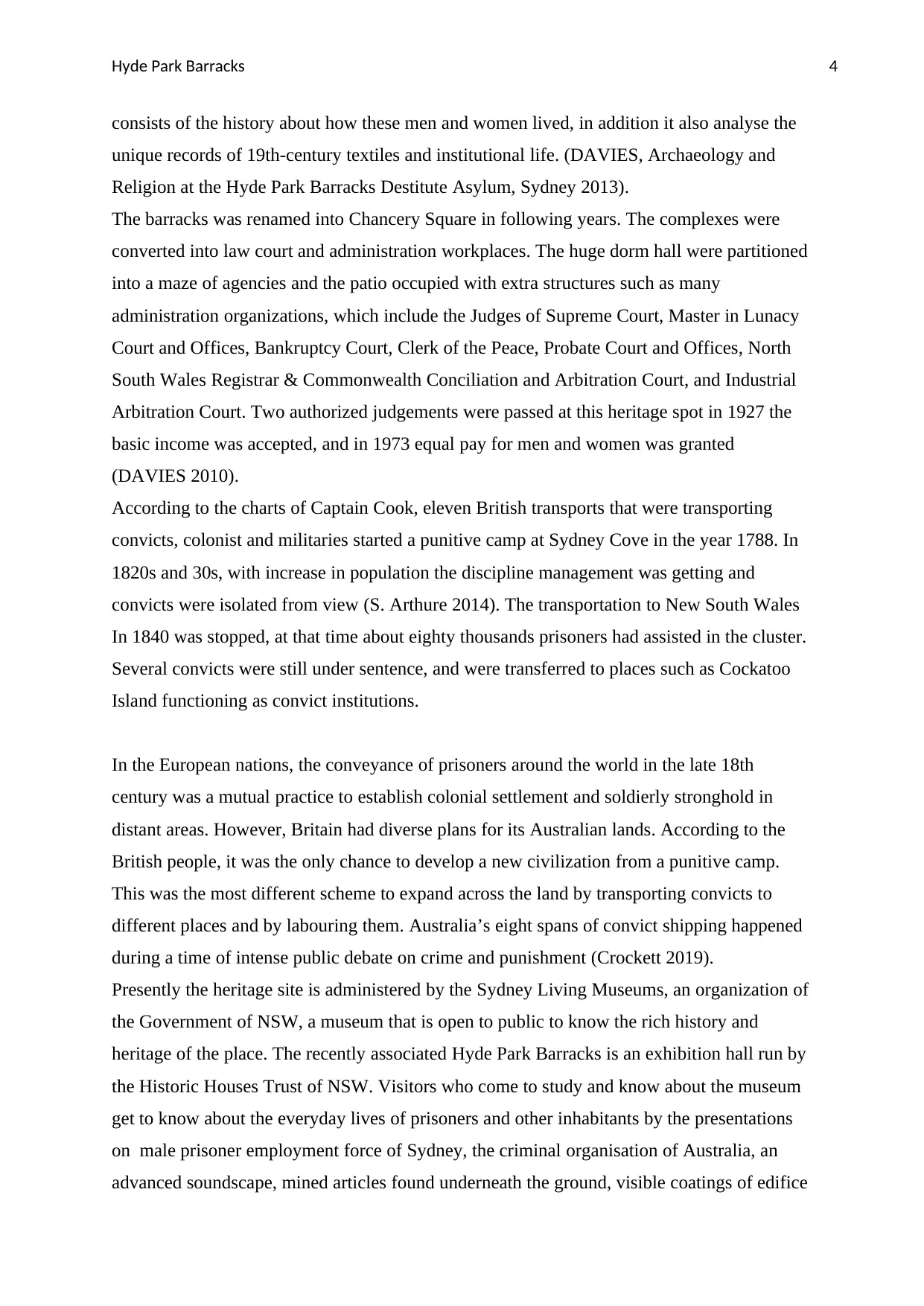
Hyde Park Barracks 4
consists of the history about how these men and women lived, in addition it also analyse the
unique records of 19th-century textiles and institutional life. (DAVIES, Archaeology and
Religion at the Hyde Park Barracks Destitute Asylum, Sydney 2013).
The barracks was renamed into Chancery Square in following years. The complexes were
converted into law court and administration workplaces. The huge dorm hall were partitioned
into a maze of agencies and the patio occupied with extra structures such as many
administration organizations, which include the Judges of Supreme Court, Master in Lunacy
Court and Offices, Bankruptcy Court, Clerk of the Peace, Probate Court and Offices, North
South Wales Registrar & Commonwealth Conciliation and Arbitration Court, and Industrial
Arbitration Court. Two authorized judgements were passed at this heritage spot in 1927 the
basic income was accepted, and in 1973 equal pay for men and women was granted
(DAVIES 2010).
According to the charts of Captain Cook, eleven British transports that were transporting
convicts, colonist and militaries started a punitive camp at Sydney Cove in the year 1788. In
1820s and 30s, with increase in population the discipline management was getting and
convicts were isolated from view (S. Arthure 2014). The transportation to New South Wales
In 1840 was stopped, at that time about eighty thousands prisoners had assisted in the cluster.
Several convicts were still under sentence, and were transferred to places such as Cockatoo
Island functioning as convict institutions.
In the European nations, the conveyance of prisoners around the world in the late 18th
century was a mutual practice to establish colonial settlement and soldierly stronghold in
distant areas. However, Britain had diverse plans for its Australian lands. According to the
British people, it was the only chance to develop a new civilization from a punitive camp.
This was the most different scheme to expand across the land by transporting convicts to
different places and by labouring them. Australia’s eight spans of convict shipping happened
during a time of intense public debate on crime and punishment (Crockett 2019).
Presently the heritage site is administered by the Sydney Living Museums, an organization of
the Government of NSW, a museum that is open to public to know the rich history and
heritage of the place. The recently associated Hyde Park Barracks is an exhibition hall run by
the Historic Houses Trust of NSW. Visitors who come to study and know about the museum
get to know about the everyday lives of prisoners and other inhabitants by the presentations
on male prisoner employment force of Sydney, the criminal organisation of Australia, an
advanced soundscape, mined articles found underneath the ground, visible coatings of edifice
consists of the history about how these men and women lived, in addition it also analyse the
unique records of 19th-century textiles and institutional life. (DAVIES, Archaeology and
Religion at the Hyde Park Barracks Destitute Asylum, Sydney 2013).
The barracks was renamed into Chancery Square in following years. The complexes were
converted into law court and administration workplaces. The huge dorm hall were partitioned
into a maze of agencies and the patio occupied with extra structures such as many
administration organizations, which include the Judges of Supreme Court, Master in Lunacy
Court and Offices, Bankruptcy Court, Clerk of the Peace, Probate Court and Offices, North
South Wales Registrar & Commonwealth Conciliation and Arbitration Court, and Industrial
Arbitration Court. Two authorized judgements were passed at this heritage spot in 1927 the
basic income was accepted, and in 1973 equal pay for men and women was granted
(DAVIES 2010).
According to the charts of Captain Cook, eleven British transports that were transporting
convicts, colonist and militaries started a punitive camp at Sydney Cove in the year 1788. In
1820s and 30s, with increase in population the discipline management was getting and
convicts were isolated from view (S. Arthure 2014). The transportation to New South Wales
In 1840 was stopped, at that time about eighty thousands prisoners had assisted in the cluster.
Several convicts were still under sentence, and were transferred to places such as Cockatoo
Island functioning as convict institutions.
In the European nations, the conveyance of prisoners around the world in the late 18th
century was a mutual practice to establish colonial settlement and soldierly stronghold in
distant areas. However, Britain had diverse plans for its Australian lands. According to the
British people, it was the only chance to develop a new civilization from a punitive camp.
This was the most different scheme to expand across the land by transporting convicts to
different places and by labouring them. Australia’s eight spans of convict shipping happened
during a time of intense public debate on crime and punishment (Crockett 2019).
Presently the heritage site is administered by the Sydney Living Museums, an organization of
the Government of NSW, a museum that is open to public to know the rich history and
heritage of the place. The recently associated Hyde Park Barracks is an exhibition hall run by
the Historic Houses Trust of NSW. Visitors who come to study and know about the museum
get to know about the everyday lives of prisoners and other inhabitants by the presentations
on male prisoner employment force of Sydney, the criminal organisation of Australia, an
advanced soundscape, mined articles found underneath the ground, visible coatings of edifice
Paraphrase This Document
Need a fresh take? Get an instant paraphrase of this document with our AI Paraphraser
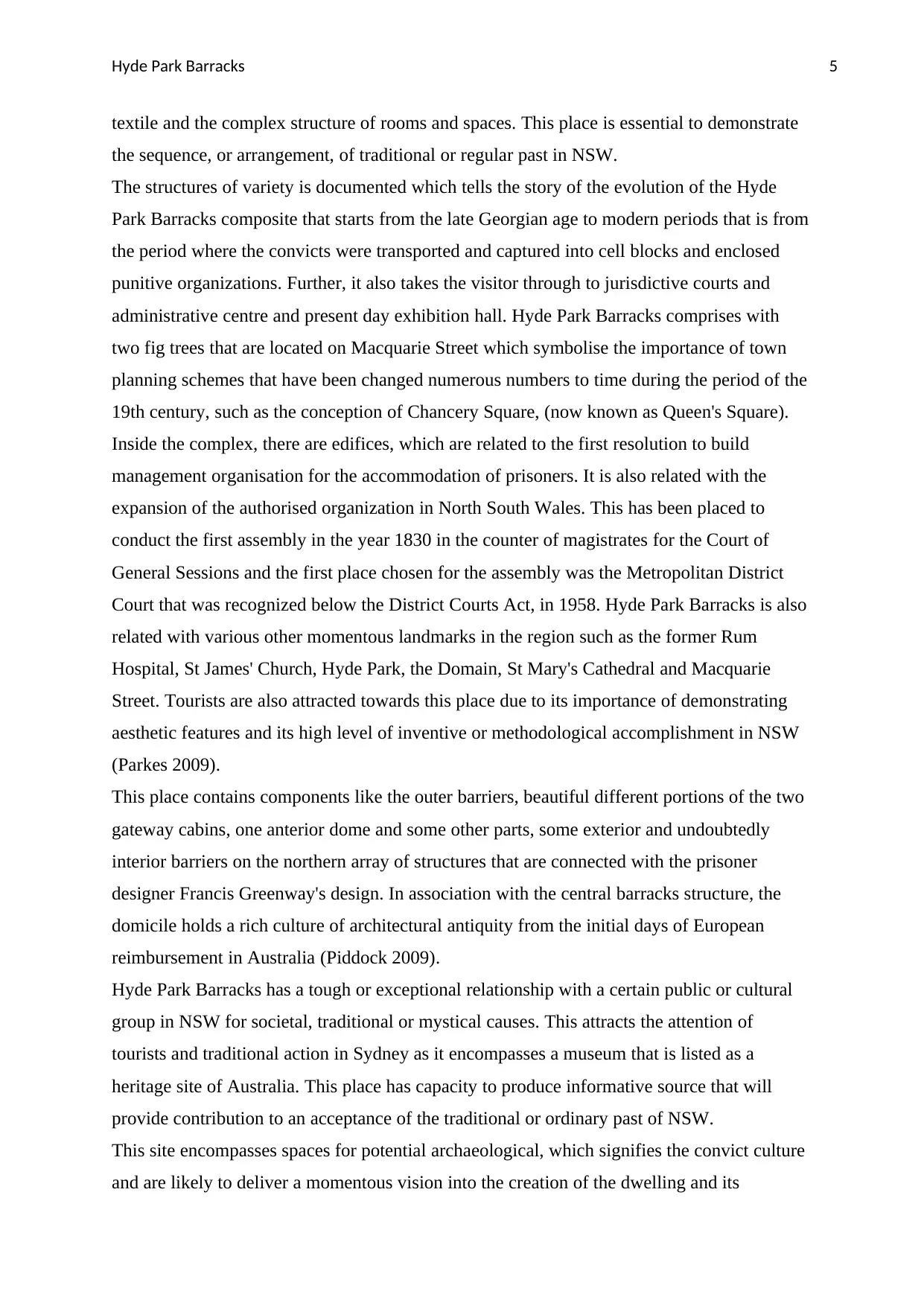
Hyde Park Barracks 5
textile and the complex structure of rooms and spaces. This place is essential to demonstrate
the sequence, or arrangement, of traditional or regular past in NSW.
The structures of variety is documented which tells the story of the evolution of the Hyde
Park Barracks composite that starts from the late Georgian age to modern periods that is from
the period where the convicts were transported and captured into cell blocks and enclosed
punitive organizations. Further, it also takes the visitor through to jurisdictive courts and
administrative centre and present day exhibition hall. Hyde Park Barracks comprises with
two fig trees that are located on Macquarie Street which symbolise the importance of town
planning schemes that have been changed numerous numbers to time during the period of the
19th century, such as the conception of Chancery Square, (now known as Queen's Square).
Inside the complex, there are edifices, which are related to the first resolution to build
management organisation for the accommodation of prisoners. It is also related with the
expansion of the authorised organization in North South Wales. This has been placed to
conduct the first assembly in the year 1830 in the counter of magistrates for the Court of
General Sessions and the first place chosen for the assembly was the Metropolitan District
Court that was recognized below the District Courts Act, in 1958. Hyde Park Barracks is also
related with various other momentous landmarks in the region such as the former Rum
Hospital, St James' Church, Hyde Park, the Domain, St Mary's Cathedral and Macquarie
Street. Tourists are also attracted towards this place due to its importance of demonstrating
aesthetic features and its high level of inventive or methodological accomplishment in NSW
(Parkes 2009).
This place contains components like the outer barriers, beautiful different portions of the two
gateway cabins, one anterior dome and some other parts, some exterior and undoubtedly
interior barriers on the northern array of structures that are connected with the prisoner
designer Francis Greenway's design. In association with the central barracks structure, the
domicile holds a rich culture of architectural antiquity from the initial days of European
reimbursement in Australia (Piddock 2009).
Hyde Park Barracks has a tough or exceptional relationship with a certain public or cultural
group in NSW for societal, traditional or mystical causes. This attracts the attention of
tourists and traditional action in Sydney as it encompasses a museum that is listed as a
heritage site of Australia. This place has capacity to produce informative source that will
provide contribution to an acceptance of the traditional or ordinary past of NSW.
This site encompasses spaces for potential archaeological, which signifies the convict culture
and are likely to deliver a momentous vision into the creation of the dwelling and its
textile and the complex structure of rooms and spaces. This place is essential to demonstrate
the sequence, or arrangement, of traditional or regular past in NSW.
The structures of variety is documented which tells the story of the evolution of the Hyde
Park Barracks composite that starts from the late Georgian age to modern periods that is from
the period where the convicts were transported and captured into cell blocks and enclosed
punitive organizations. Further, it also takes the visitor through to jurisdictive courts and
administrative centre and present day exhibition hall. Hyde Park Barracks comprises with
two fig trees that are located on Macquarie Street which symbolise the importance of town
planning schemes that have been changed numerous numbers to time during the period of the
19th century, such as the conception of Chancery Square, (now known as Queen's Square).
Inside the complex, there are edifices, which are related to the first resolution to build
management organisation for the accommodation of prisoners. It is also related with the
expansion of the authorised organization in North South Wales. This has been placed to
conduct the first assembly in the year 1830 in the counter of magistrates for the Court of
General Sessions and the first place chosen for the assembly was the Metropolitan District
Court that was recognized below the District Courts Act, in 1958. Hyde Park Barracks is also
related with various other momentous landmarks in the region such as the former Rum
Hospital, St James' Church, Hyde Park, the Domain, St Mary's Cathedral and Macquarie
Street. Tourists are also attracted towards this place due to its importance of demonstrating
aesthetic features and its high level of inventive or methodological accomplishment in NSW
(Parkes 2009).
This place contains components like the outer barriers, beautiful different portions of the two
gateway cabins, one anterior dome and some other parts, some exterior and undoubtedly
interior barriers on the northern array of structures that are connected with the prisoner
designer Francis Greenway's design. In association with the central barracks structure, the
domicile holds a rich culture of architectural antiquity from the initial days of European
reimbursement in Australia (Piddock 2009).
Hyde Park Barracks has a tough or exceptional relationship with a certain public or cultural
group in NSW for societal, traditional or mystical causes. This attracts the attention of
tourists and traditional action in Sydney as it encompasses a museum that is listed as a
heritage site of Australia. This place has capacity to produce informative source that will
provide contribution to an acceptance of the traditional or ordinary past of NSW.
This site encompasses spaces for potential archaeological, which signifies the convict culture
and are likely to deliver a momentous vision into the creation of the dwelling and its
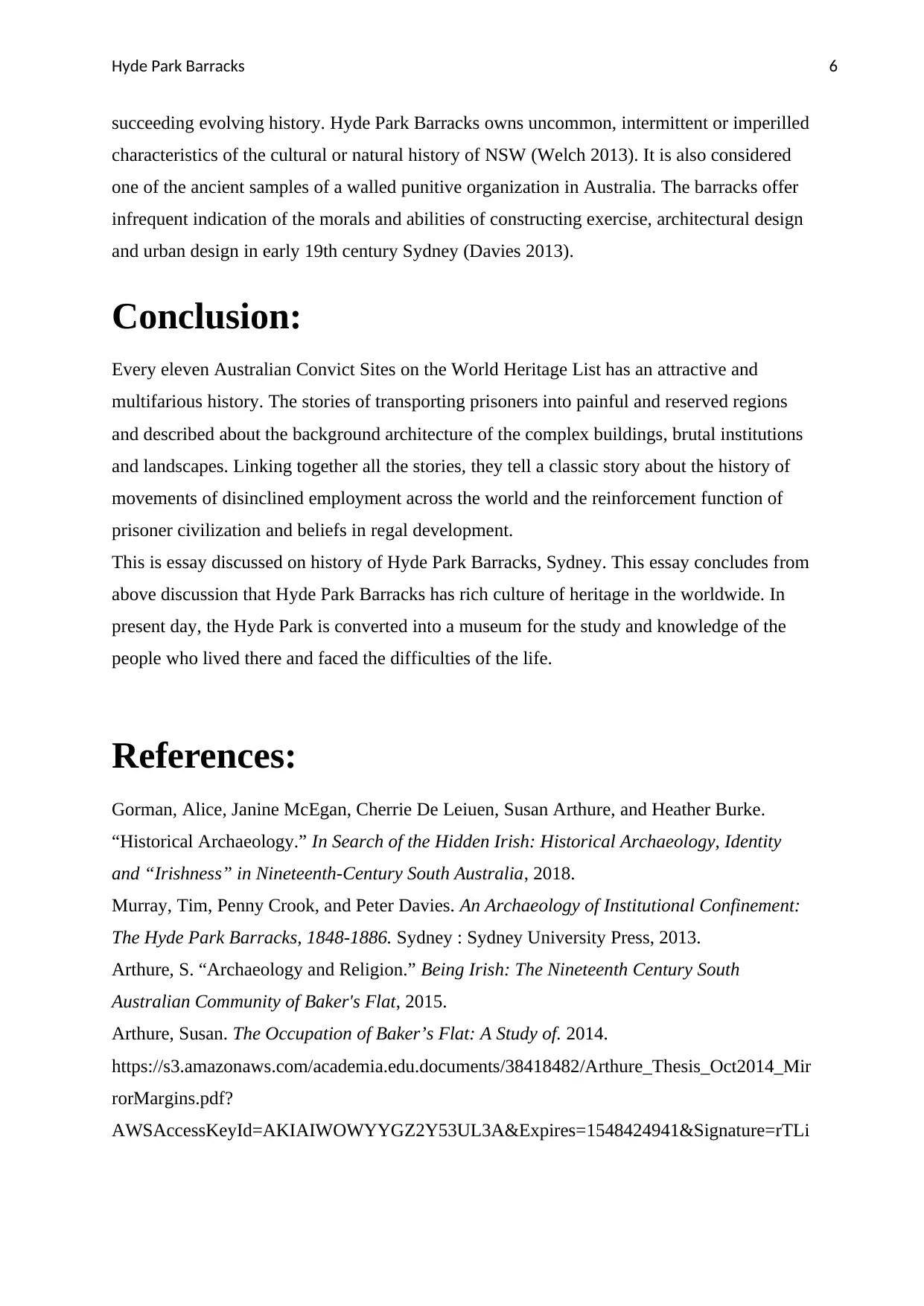
Hyde Park Barracks 6
succeeding evolving history. Hyde Park Barracks owns uncommon, intermittent or imperilled
characteristics of the cultural or natural history of NSW (Welch 2013). It is also considered
one of the ancient samples of a walled punitive organization in Australia. The barracks offer
infrequent indication of the morals and abilities of constructing exercise, architectural design
and urban design in early 19th century Sydney (Davies 2013).
Conclusion:
Every eleven Australian Convict Sites on the World Heritage List has an attractive and
multifarious history. The stories of transporting prisoners into painful and reserved regions
and described about the background architecture of the complex buildings, brutal institutions
and landscapes. Linking together all the stories, they tell a classic story about the history of
movements of disinclined employment across the world and the reinforcement function of
prisoner civilization and beliefs in regal development.
This is essay discussed on history of Hyde Park Barracks, Sydney. This essay concludes from
above discussion that Hyde Park Barracks has rich culture of heritage in the worldwide. In
present day, the Hyde Park is converted into a museum for the study and knowledge of the
people who lived there and faced the difficulties of the life.
References:
Gorman, Alice, Janine McEgan, Cherrie De Leiuen, Susan Arthure, and Heather Burke.
“Historical Archaeology.” In Search of the Hidden Irish: Historical Archaeology, Identity
and “Irishness” in Nineteenth-Century South Australia, 2018.
Murray, Tim, Penny Crook, and Peter Davies. An Archaeology of Institutional Confinement:
The Hyde Park Barracks, 1848-1886. Sydney : Sydney University Press, 2013.
Arthure, S. “Archaeology and Religion.” Being Irish: The Nineteenth Century South
Australian Community of Baker's Flat, 2015.
Arthure, Susan. The Occupation of Baker’s Flat: A Study of. 2014.
https://s3.amazonaws.com/academia.edu.documents/38418482/Arthure_Thesis_Oct2014_Mir
rorMargins.pdf?
AWSAccessKeyId=AKIAIWOWYYGZ2Y53UL3A&Expires=1548424941&Signature=rTLi
succeeding evolving history. Hyde Park Barracks owns uncommon, intermittent or imperilled
characteristics of the cultural or natural history of NSW (Welch 2013). It is also considered
one of the ancient samples of a walled punitive organization in Australia. The barracks offer
infrequent indication of the morals and abilities of constructing exercise, architectural design
and urban design in early 19th century Sydney (Davies 2013).
Conclusion:
Every eleven Australian Convict Sites on the World Heritage List has an attractive and
multifarious history. The stories of transporting prisoners into painful and reserved regions
and described about the background architecture of the complex buildings, brutal institutions
and landscapes. Linking together all the stories, they tell a classic story about the history of
movements of disinclined employment across the world and the reinforcement function of
prisoner civilization and beliefs in regal development.
This is essay discussed on history of Hyde Park Barracks, Sydney. This essay concludes from
above discussion that Hyde Park Barracks has rich culture of heritage in the worldwide. In
present day, the Hyde Park is converted into a museum for the study and knowledge of the
people who lived there and faced the difficulties of the life.
References:
Gorman, Alice, Janine McEgan, Cherrie De Leiuen, Susan Arthure, and Heather Burke.
“Historical Archaeology.” In Search of the Hidden Irish: Historical Archaeology, Identity
and “Irishness” in Nineteenth-Century South Australia, 2018.
Murray, Tim, Penny Crook, and Peter Davies. An Archaeology of Institutional Confinement:
The Hyde Park Barracks, 1848-1886. Sydney : Sydney University Press, 2013.
Arthure, S. “Archaeology and Religion.” Being Irish: The Nineteenth Century South
Australian Community of Baker's Flat, 2015.
Arthure, Susan. The Occupation of Baker’s Flat: A Study of. 2014.
https://s3.amazonaws.com/academia.edu.documents/38418482/Arthure_Thesis_Oct2014_Mir
rorMargins.pdf?
AWSAccessKeyId=AKIAIWOWYYGZ2Y53UL3A&Expires=1548424941&Signature=rTLi
⊘ This is a preview!⊘
Do you want full access?
Subscribe today to unlock all pages.

Trusted by 1+ million students worldwide
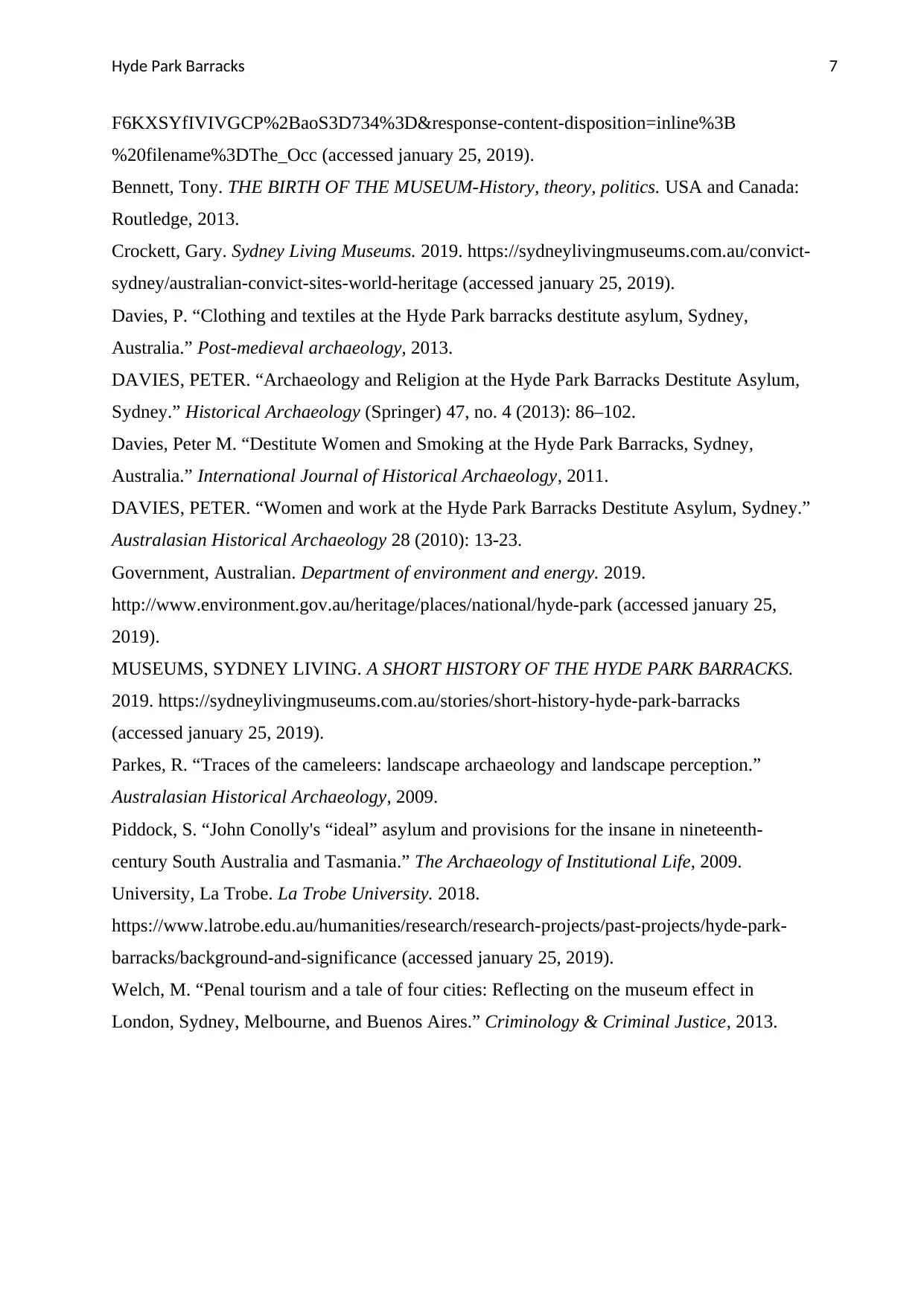
Hyde Park Barracks 7
F6KXSYfIVIVGCP%2BaoS3D734%3D&response-content-disposition=inline%3B
%20filename%3DThe_Occ (accessed january 25, 2019).
Bennett, Tony. THE BIRTH OF THE MUSEUM-History, theory, politics. USA and Canada:
Routledge, 2013.
Crockett, Gary. Sydney Living Museums. 2019. https://sydneylivingmuseums.com.au/convict-
sydney/australian-convict-sites-world-heritage (accessed january 25, 2019).
Davies, P. “Clothing and textiles at the Hyde Park barracks destitute asylum, Sydney,
Australia.” Post-medieval archaeology, 2013.
DAVIES, PETER. “Archaeology and Religion at the Hyde Park Barracks Destitute Asylum,
Sydney.” Historical Archaeology (Springer) 47, no. 4 (2013): 86–102.
Davies, Peter M. “Destitute Women and Smoking at the Hyde Park Barracks, Sydney,
Australia.” International Journal of Historical Archaeology, 2011.
DAVIES, PETER. “Women and work at the Hyde Park Barracks Destitute Asylum, Sydney.”
Australasian Historical Archaeology 28 (2010): 13-23.
Government, Australian. Department of environment and energy. 2019.
http://www.environment.gov.au/heritage/places/national/hyde-park (accessed january 25,
2019).
MUSEUMS, SYDNEY LIVING. A SHORT HISTORY OF THE HYDE PARK BARRACKS.
2019. https://sydneylivingmuseums.com.au/stories/short-history-hyde-park-barracks
(accessed january 25, 2019).
Parkes, R. “Traces of the cameleers: landscape archaeology and landscape perception.”
Australasian Historical Archaeology, 2009.
Piddock, S. “John Conolly's “ideal” asylum and provisions for the insane in nineteenth-
century South Australia and Tasmania.” The Archaeology of Institutional Life, 2009.
University, La Trobe. La Trobe University. 2018.
https://www.latrobe.edu.au/humanities/research/research-projects/past-projects/hyde-park-
barracks/background-and-significance (accessed january 25, 2019).
Welch, M. “Penal tourism and a tale of four cities: Reflecting on the museum effect in
London, Sydney, Melbourne, and Buenos Aires.” Criminology & Criminal Justice, 2013.
F6KXSYfIVIVGCP%2BaoS3D734%3D&response-content-disposition=inline%3B
%20filename%3DThe_Occ (accessed january 25, 2019).
Bennett, Tony. THE BIRTH OF THE MUSEUM-History, theory, politics. USA and Canada:
Routledge, 2013.
Crockett, Gary. Sydney Living Museums. 2019. https://sydneylivingmuseums.com.au/convict-
sydney/australian-convict-sites-world-heritage (accessed january 25, 2019).
Davies, P. “Clothing and textiles at the Hyde Park barracks destitute asylum, Sydney,
Australia.” Post-medieval archaeology, 2013.
DAVIES, PETER. “Archaeology and Religion at the Hyde Park Barracks Destitute Asylum,
Sydney.” Historical Archaeology (Springer) 47, no. 4 (2013): 86–102.
Davies, Peter M. “Destitute Women and Smoking at the Hyde Park Barracks, Sydney,
Australia.” International Journal of Historical Archaeology, 2011.
DAVIES, PETER. “Women and work at the Hyde Park Barracks Destitute Asylum, Sydney.”
Australasian Historical Archaeology 28 (2010): 13-23.
Government, Australian. Department of environment and energy. 2019.
http://www.environment.gov.au/heritage/places/national/hyde-park (accessed january 25,
2019).
MUSEUMS, SYDNEY LIVING. A SHORT HISTORY OF THE HYDE PARK BARRACKS.
2019. https://sydneylivingmuseums.com.au/stories/short-history-hyde-park-barracks
(accessed january 25, 2019).
Parkes, R. “Traces of the cameleers: landscape archaeology and landscape perception.”
Australasian Historical Archaeology, 2009.
Piddock, S. “John Conolly's “ideal” asylum and provisions for the insane in nineteenth-
century South Australia and Tasmania.” The Archaeology of Institutional Life, 2009.
University, La Trobe. La Trobe University. 2018.
https://www.latrobe.edu.au/humanities/research/research-projects/past-projects/hyde-park-
barracks/background-and-significance (accessed january 25, 2019).
Welch, M. “Penal tourism and a tale of four cities: Reflecting on the museum effect in
London, Sydney, Melbourne, and Buenos Aires.” Criminology & Criminal Justice, 2013.
1 out of 7
Your All-in-One AI-Powered Toolkit for Academic Success.
+13062052269
info@desklib.com
Available 24*7 on WhatsApp / Email
![[object Object]](/_next/static/media/star-bottom.7253800d.svg)
Unlock your academic potential
Copyright © 2020–2025 A2Z Services. All Rights Reserved. Developed and managed by ZUCOL.
